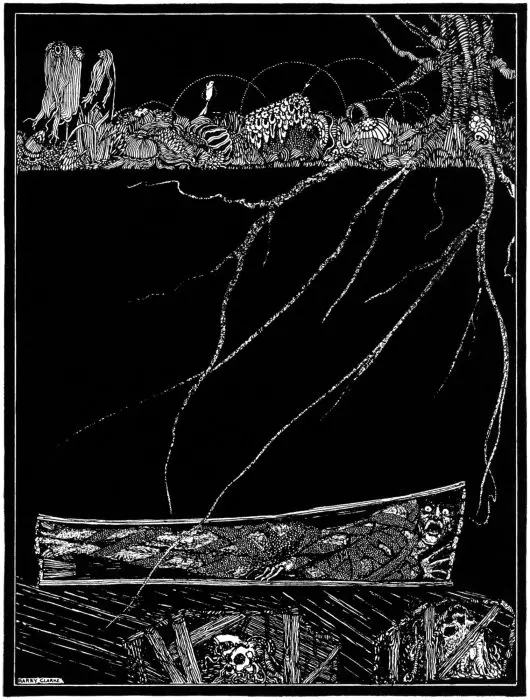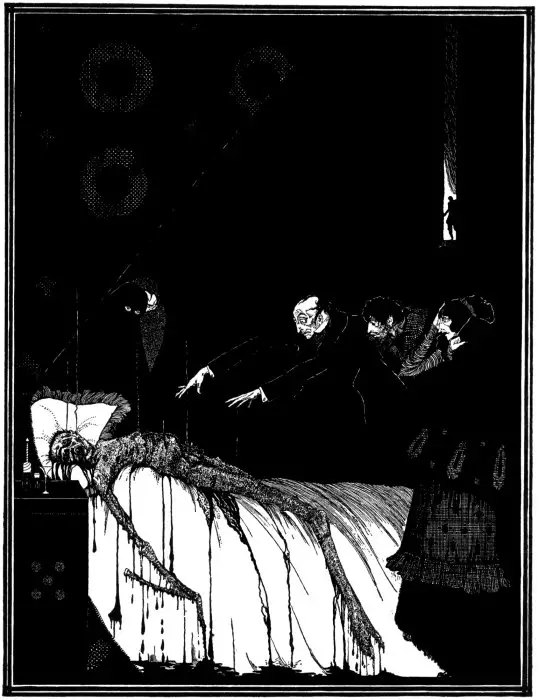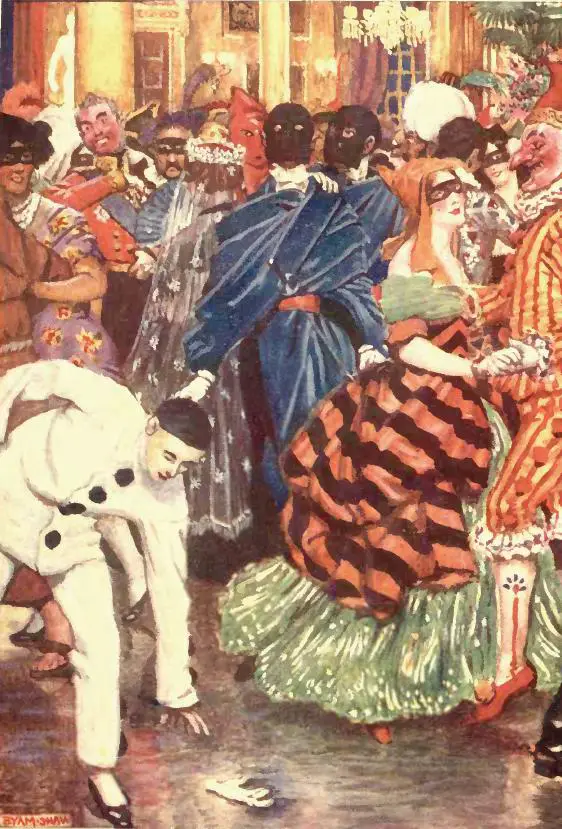Edgar Allan Poe, a 19th-century American author, is known for writing works that are filled with intense emotion. As a result, many of them fit perfectly into the spooky season’s chilling aesthetic, therefore, they are the perfect thing to read this season if you enjoy getting chills down your spine.

Here are 10 of the most fear-inspiring stories by Edgar Allan Poe.
The Masque of the Red Death
The Masque of the Red Death, published in 1842, might hit close to home whether you’ve read it or not. The story describes the fear of a terrible plague that’s going around. Sound familiar? The plague, known as the Red Death, prompts the main character to quarantine himself in an abbey. Unfortunately, he decides to invite 1,000 other wealthy nobles to join him there for a masquerade ball. When a mysterious figure dressed as the personification of the Red Death shows up, you can probably guess what happens next. The guest ends up not being real and everyone in the abbey contracts the Red Death, dying soon after.
Mesmeric Revelation
Mesmeric Revelation, published in 1849, is a chilling story. The narrator, known as “P,” hypnotizes his dying friend, Mr. Vankirk, to learn about his beliefs. While hypnotized, the two of them discuss and argue on various topics regarding the nature of the universe.

Eventually, they end up arguing over whether or not God exists, and when “P” attempts to wake Mr. Vankirk from his hypnotized state, he discovers that his friend had died at some point while they were talking. The cold hardness of his body indicates that Mr. Vankirk has been dead for a long while. This causes “P” to wonder if he was talking to Mr. Vankirk or his friend’s soul, hidden in the shadows.
The Cask of Amontillado
The Cask of Amontillado, published in 1846, is a story of twisted revenge and horrific murder. Montresor, the narrator, feels that his acquaintance, Fortunado, has insulted him. In response, he takes on the role of judge, jury, and execution but his reasoning is mostly based on past experience rather than fact. Montresor lures him down to his vaults with the promise of a delicious Spanish wine, known as Amontillado. However, it ends up being a trap and Fortunado soon finds himself chained to a wall in a small crypt. He wails and screams as Montresor begins bricking up the entrance but becomes silent when Montresor finishes his wicked deed. Montresor then departs, leaving Fortunado to rot in the crypt for all eternity.
The Premature Burial

The Premature Burial, published in 1844, describes the familiar fear of being buried alive. In this story, that fear has a terrible hold on the main character. He has a disease that causes him to slip into an unconscious state, which appears like death. He becomes obsessed with finding ways to avoid a live burial. Then, his fear seems to come true when he finds himself in a dark, enclosed space.
He eventually realizes that he’s on a boat, not in a grave, and snaps out of his phobia. After that, his episodes of unconsciousness cease. The episodes were a symptom of his fear and went away when he recovered from his phobia.
The Fall of the House of Usher
The Fall of the House of Usher, published in 1839, focuses heavily on feelings of fear, guilt, and impending doom. It is one of Poe’s most emotional works. Roderick Usher, who is almost constantly hysterical, invites the narrator to the House of Usher where he lives with his sister, Madeline. Unfortunately, Madeline suffers from catalepsy and dies at some point. Roderick insists on burying Madeline in the family tomb and the narrator helps him. However, Roderick’s hysterical state worsens after that. After both men hear screaming in the house, Roderick reveals that they buried Madeline alive and she is trying to escape her tomb. She appears before them then, bloody from her escape, and kills her brother before expiring. The sight sends the narrator fleeing from the home and when he looks back he witnesses the house crumbling into ruin behind him.
Berenice
Berenice, published in 1835, features another live burial but this one includes a twisted obsession. Egaeus and Berenice, his cousin, are about to marry. Egaeus suffers from an obsessive disorder that makes him fixate on objects and enter trance-like states when obsessing over something. He becomes fixated on Berenice’s teeth, causing him to think about them constantly and have the desire to hold them. Berenice suffers from a disease where catalepsy is one of the symptoms. She becomes very sick and dies. After her death, Egaeus comes out of a trance and realizes he has disturbed her grave and pulled out all of her teeth. Then, a servant tells him that Berenice is alive. It turns out that Egaeus had pulled out her teeth while she was still alive. Creepy!

The Facts in the Case of M. Valdemar
The Facts in the Case of M. Valdemar, published in 1845, is another story featuring hypnosis. It is one of Poe’s most suspenseful works. The narrator wants to experiment with hypnosis to find out what will happen if someone is hypnotized at the point of death. He finds Valdemar, who is sick with tuberculosis. He agrees to the narrator’s experiment and becomes hypnotized by the narrator.
The narrator keeps him in trance for seven months, though Valdemar appears undoubtedly dead the entire time. When the narrator tries to wake him, Valdemar’s voice answers his questions but his face doesn’t move. He then begs the narrator to put him back to sleep and begins shouting the word “dead” over and over. The narrator tries to bring him out of the trance only to witness the horrific, rapid decay of Valdemar’s body until he’s nothing but a nearly liquid mass.
The Pit and the Pendulum
The Pit and the Pendulum, published in 1842, is a story about torture. Its heavy focus on the senses can inspire a sense of fear in the reader. The officials of the Spanish Inquisition sentence the narrator to death. He finds himself in a dark room and discovers a large pit within it. After fainting, he awakens to find himself strapped to a wooden slab underneath a pendulum which swings back and forth, lowering slowly. The pendulum will eventually slice him in half but he escapes by attracting rats to chew through his bindings. But then, the walls of his cell become red hot and begin closing in on him, forcing him toward a deep pit. However, before he can fall in, the walls retract and an arm pulls him to safety. The French army comes to his rescue after capturing the city that imprisoned him.

William Wilson
William Wilson, published in 1839, is a story where a man’s conscience is presented as a dopplegänger. It begins with William Wilson’s childhood when he meets a boy who looks similar to him and begins going by his name because it sounds better. The lookalike follows him through school and the rest of his life, whispering things in his ear and getting William into trouble by exposing his bad behavior in one way or another.
William eventually becomes enraged and the two of them fight. One stabs the other and it turns out that William has stabbed himself; the double having never actually been there. Seeing your own dopplegänger is a bad omen. It usually leads to misfortune, if not death, and in William’s case, it was death by his own hand.
The Tell-Tale Heart
The Tell-Tale Heart, published in 1843, recounts a murder from the perspective of the manic murderer. The narrator, who tries to convince the reader that he’s not insane, explains why he murdered the old man he was living with. The narrator experienced intense anxiety and fear whenever looking at the white, blind eye of the old man and went about planning his murder when he could take no more. He describes how perfectly calculated his murder plot was and how he dismembered the old man in the bathtub and buried him under the floorboards. The narrator would have gotten away with the murder if the sound of the old man’s heart beating under the floor didn’t drive him mad. The madness it caused led him to reveal the murder to the police.
That was 10 of the scariest Edgar Allan Poe short stories. Which one did you find scariest? Want to learn more about Edgar Allan Poe? Feel free to comment with your thoughts!
